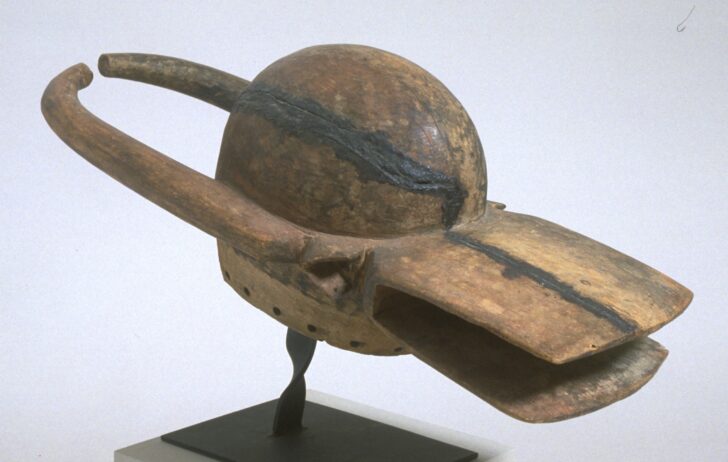Mask
Chamba

Description
The bush cow mask, representing a West African buffalo, is commonly found among the various ethnic groups of Nigeria, including the Chamba. The dome-like shape of the cranium and the horns' roundness and curvature distinguish the Chamba prototype from the bush cow masks made by other Nigerian peoples. The mask has been associated with numerous rituals including funeral ceremonies in which it was said to guide the soul of the deceased into the land of the dead. It has also appeared in ceremonies to protect the village from evil spirits and to ward off sickness.
Subject Matter:
A fusion of a human-shaped skull and an bushcow or buffalo skull, this mask was created by the Chamba peoples of eastern Nigeria and western Cameroon. Used in masquerades to perform the passage of a human and animal character from the wild to the village, the mask was usually worn with a suit of overlapping fibers that hung from the bottom of the mask and the performer's waist. Western Chamba peoples that speak the Daka language call the masquerade Nam-Gbalang, which refers to the unruly behavior (gbalang) of the animal (nam), while the mask is called Lang-gbadna, lang meaning frightening and gbadna meaning mask. In the east, Chamba peoples that speak the Leko language refer to the mask as vara, which means skull. This mask could possibly be an eastern Chamba Leko mask, as it has a high dome and no other features but horns, ears, and a mouth. The mask also appears to have been painted, one half red and one half black, a feature of northern Chamba masks. In masks painted one color, female masks were colored black and and male masks were colored red. Masks with both colors were considered female.
References Cited:
Berns, Marla C., Richard Fardon, and Sidney Littlefield Kasfir, eds. 2011. Central Nigeria Unmasked: Arts of the Benue River Valley. Los Angeles: UCLA Fowler Museum of Cultural History.
Physical Description:
Wooden helmet-shaped mask with a large central dome. From the front two flat plates form a mouth, with triangular ears on each side while two curved horns extend back. There is a crack along the center of the mask that appears to have been repaired locally with pitch or tar.
Usage Rights:
If you are interested in using an image for a publication, please visit https://umma.umich.edu/request-image/ for more information and to fill out the online Image Rights and Reproductions Request Form.